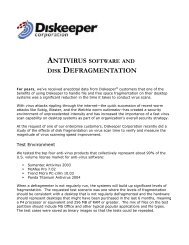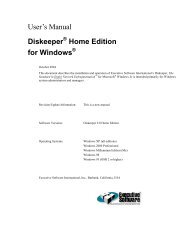Diskeeper 10 User's Manual
Diskeeper 10 User's Manual
Diskeeper 10 User's Manual
You also want an ePaper? Increase the reach of your titles
YUMPU automatically turns print PDFs into web optimized ePapers that Google loves.
22 <strong>Diskeeper</strong> Operation<br />
• Overall fragmentation<br />
• MFT fragmentation<br />
• Paging file fragmentation<br />
• Available free space<br />
<strong>Diskeeper</strong> uses these factors to determine a volume health index each time it analyzes or defragments a volume.<br />
Volume health is rated into three categories—Healthy, Warning and Critical.<br />
This table shows the Warning and Critical levels used in determining the reliability index.<br />
Reliability Factor Warning Level Critical Level<br />
Overall Fragmentation > <strong>10</strong>% fragmentation > 50% fragmentation<br />
MFT Fragmentation > 250 fragments >2000 fragments<br />
Paging File Fragmentation > 250 fragments >1500 fragments<br />
Free Space < 15% free space < 5% free space<br />
I-FAAST Statistics Section<br />
Displayed only on <strong>Diskeeper</strong> editions that include the Intelligent File Access Acceleration Sequencing<br />
Technology (I-FAAST) feature, this section of the Job Report tab provides statistical information about I-<br />
FAAST Defragmentation Jobs and the related performance improvement. The values shown in this section are<br />
based on measurements taken during I-FAAST processing, and they show the potential performance gain you<br />
can expect from the selected volume, as well as the actual measured throughput rates for the volume.<br />
The actual performance gain from using I-FAAST will fluctuate depending volume activity, but the statistics<br />
shown in this section of the Job Report tab give you an indication of the improvement you can expect to see.<br />
Access Time Section<br />
This section of the Job Report tab displays a graph illustrating the performance characteristics of the volume,<br />
based on current read times calculated by <strong>Diskeeper</strong>—both for all the files on the drive and for only the<br />
fragmented files on the volume. It also shows the expected optimum read time for all the files and for only the<br />
fragmented files. This gives you a detailed picture of your performance losses due to fragmentation, and the<br />
expected improvement you will see after defragmentation.<br />
Each time you analyze or defragment a disk, <strong>Diskeeper</strong> calculates the read time of the disk in two ways. First, it<br />
shows the predicted time to read all the files on the disk. Secondly, it shows the time to read only the<br />
fragmented files. Additionally, it determines the optimum (fastest) read time potential for the disk.<br />
It should be noted that by default, the performance analysis is based on pre-determined disk performance values<br />
measured as a part of disk performance research done by <strong>Diskeeper</strong> Corporation. To get a more accurate<br />
performance measurement of your actual disks, <strong>Diskeeper</strong> must scan your drives to measure their performance.<br />
Since this measurement can briefly slow down your computer, this scan operation is disabled by default, but<br />
you can turn it on easily. The Enable volume performance data collection option is described in the<br />
<strong>Diskeeper</strong> Configuration Properties section on page 49.<br />
Statistics Section<br />
This section of the Job Report tab shows useful information about your volume after either analysis or<br />
defragmentation. Note that most of the information shown here can also be recorded in the <strong>Diskeeper</strong> Event<br />
Log.






